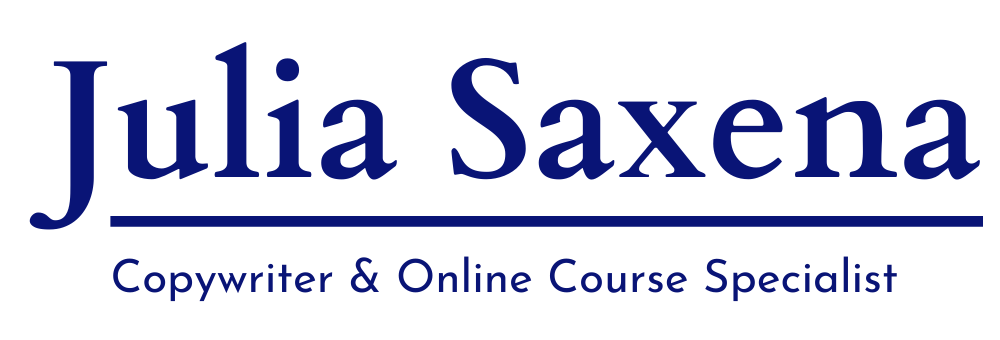Launching anything for the first time is scary!
You’re tossing and turning at night, wondering if anyone will buy. If you’re really onto something or if you’re overestimating the significance of your idea.
You’re following the advice of other creators and trying a bunch of new strategies, hoping that some of it will move the needle.
We can tell you now that going through all the second-guessing and sleepless nights is worth it.
Because coming out on the other side with 20 students enrolled and 5-figures showing up in the Teachable dashboard is an incredible feeling.
But let’s rewind the clock to fully tell the story of this launch.
Cam contacted me in August about working together to launch an online course.
We connected through Write of Passage, a course about writing and publishing online. As Cam’s specialty is video, he wanted to create a similar transformative learning experience for people using video as their output.
So, we teamed up to make it a reality.
This blog post is a recap of what it took to sign up 20 students to a brand-new program, the activities that drove the launch, and what we’ve learned along the way.
But first off, we faced one critical question…
What should we call this thing?
Some people we told about the course suggested “Lights, Cam, Action!” But that didn’t seem right.
In a good old brainstorming session, we arrived at 26 potential course names.
Lesson learned: You’ll have to go through the really lame ones like “Video made easy” to eventually arrive at the ideas that don’t completely suck.
The four best contenders went into a Twitter survey where “Capable on Camera” came out on top.
In the end, we decided to go with Minimum Viable Video as we wanted the word “video” in the names and liked the reference to the startup world.
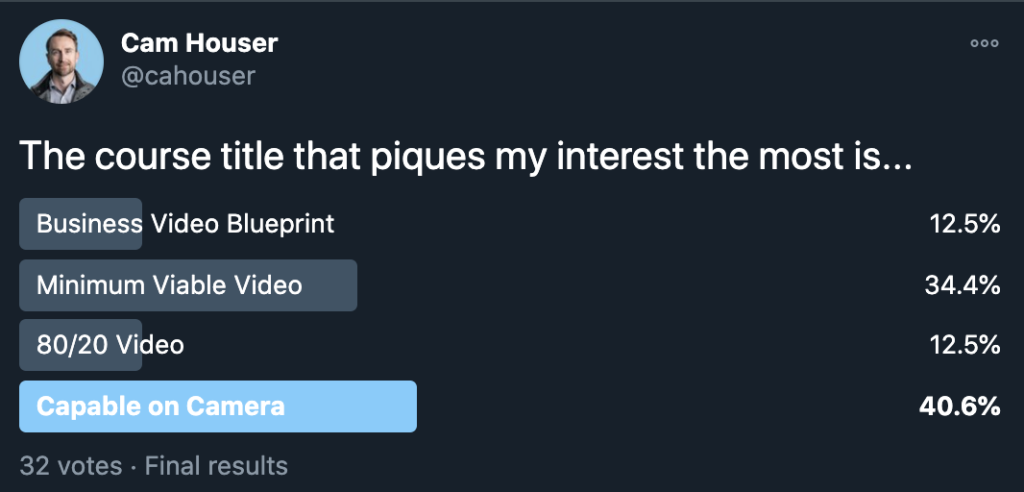
Which activities mattered for the launch?
In September, we decided to kick off the first cohort of Minimum Viable Video on November 17. This allowed for about two months to get everything ready and enroll our students.
Here are the six activities that made the biggest difference in building trust with our audience and ultimately driving sales.
Free workshops
Cam hosted multiple free workshops over the next several weeks. In 90 minutes, he took participants from zero to finished video while teaching the basics of video composition, audio, and lighting.
These workshops served two purposes. They tested…
- if people actually wanted to learn how to make videos.
- if the lessons Cam had prepared were, in fact, what students wanted to learn.
Also, every workshop was positioned a bit differently to see what aspects of video people were interested in learning.
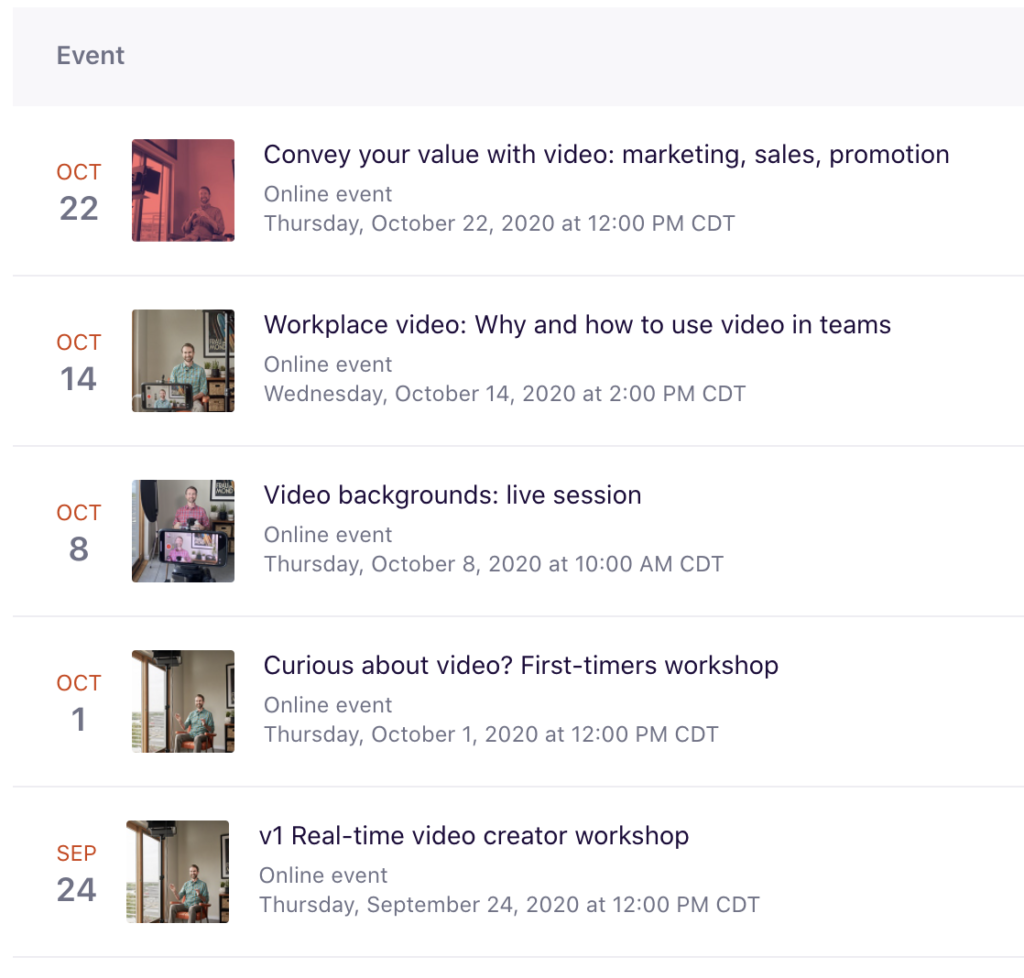
Cam created Eventbrite pages to manage sign-ups and promoted the workshops via Twitter, LinkedIn, and his newsletter.
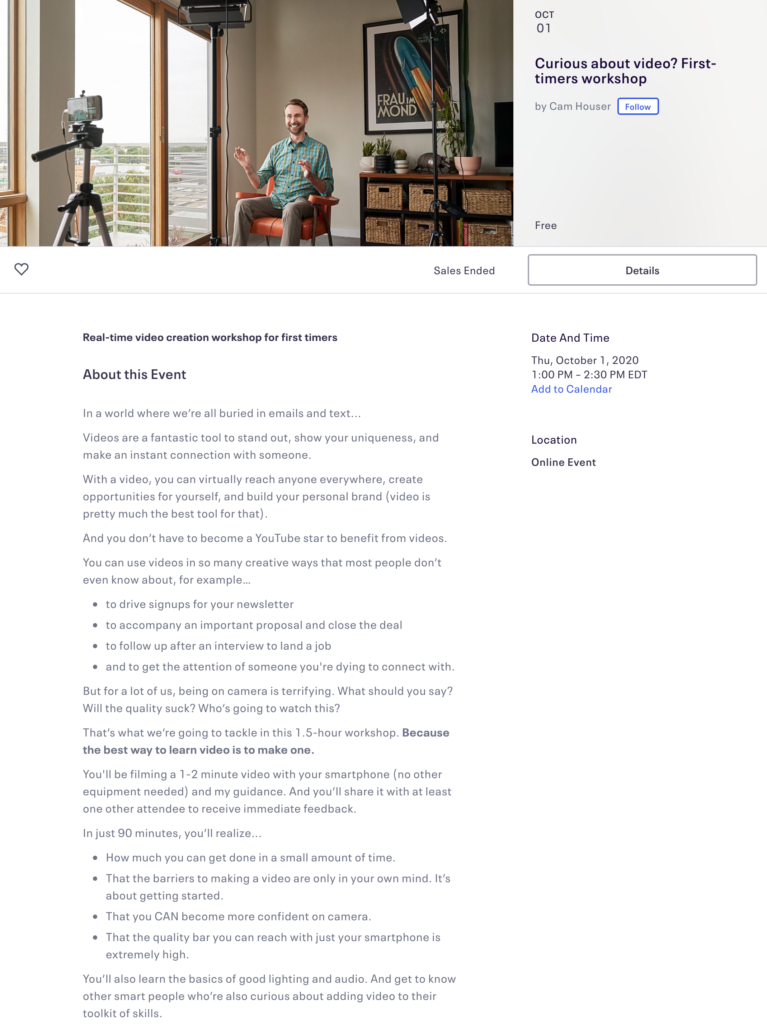
Workshop attendance varied. While one workshop had 40 participants, another one had three (of which two people are now students).
The overall feedback was very positive. We gathered a lot of insights into the barriers people were facing with regard to showing up on camera. And got some great testimonials, like the one from Jim Liu below, which we then used on our sales page.
“A huge thank you. I thought your overall approach for getting us to go from zero to one was awesome. Zero being deathly afraid of making a video to one being “hey it’s not all that bad”. I think the main benefit I got out of it was just overcoming my sense of internal friction in terms of how I think about video. Before it felt like a really high effort, and lots of hurdles in terms of equipment, all the steps, the quality. But you did an awesome job of lowering that friction.”
Lead magnet
Email lists drive course sales. But how do we get people to join it? With a lead magnet!
We created the free email course “The Era of Video: Why now is the perfect time to leverage the power of video to grow your business and accelerate your career” in ConvertKit.
Six emails delivered over six days teach new subscribers…
- how video can help them build connections with people they’ve never met
- how video is a “pandemic-proof” marketing strategy
- how video is conquering more and more platforms (and why that’s great news)
- how video outperforms all other forms of content (and saves tons of time)
- And how they can produce high-grade videos with only about $100 equipment.
The emails contain a mix of videos and text emails, which is an experiment in itself. We let the subscribers judge if the videos or the text was more impactful for them.
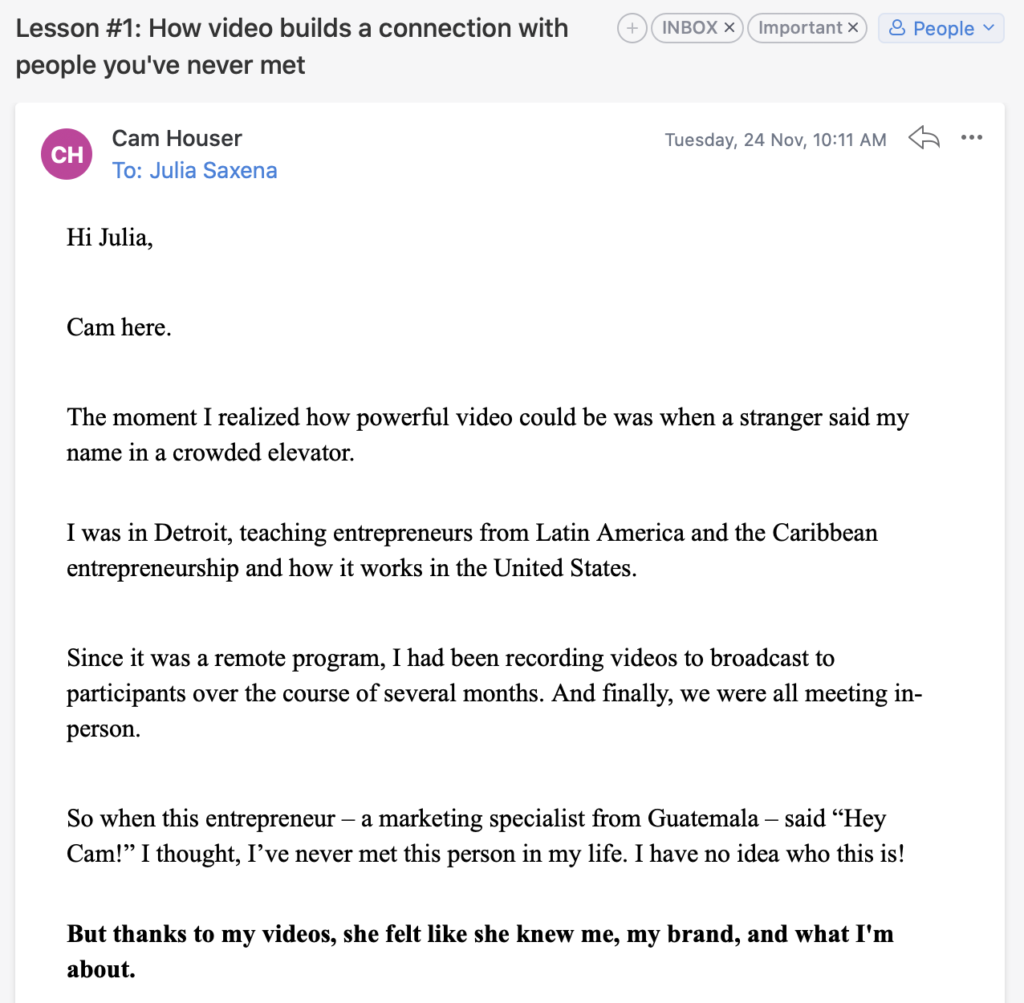
You might be wondering why this lead magnet isn’t some sort of video checklist or guide to making your first video.
At this point in their journey, we want to teach people how to think, not what to do. A checklist wouldn’t be useful because there’s so much holding people back from going on camera. The goal is to instill the necessary mindset and beliefs and overcome any limitations and misconceptions about video. That sets our new subscribers up to take the right actions later.
Why did we choose an email course? First of all, it’s easy to set up. There’s no design needed. Even better, it gets people into the habit of opening our emails. And that’s exactly what we want, going into a launch.
If you’re curious to learn more about generating leads with an email course, I’ve written a detailed blog post about it.
Launch email sequence
Email was the main channel that people would hear about our launch. Cam had an existing email list of around 350 subscribers on Substack plus new subscribers from our lead magnet.
Over a period of one month, we sent a series of 16 emails to our list. The subscribers received launch emails as well as Cam’s regular weekly newsletter “Learn from Rulebreakers.”
Each email had a link on the bottom as an option to opt out of hearing about the Minimum Viable Video launch. This way, people could stay on the main email list and still get the newsletter but wouldn’t be bothered with the launch if they weren’t interested.
The first emails focused on the why behind video and the beliefs associated with getting started. After we opened the cart on October 26, we talked about what people will get out of the course and why this is the right time to do it. Our case study email provided real-life proof that Cam’s approach to video works. The last emails before closing were designed to overcome any remaining objections and invited readers to reach out if they were still on the fence.
In the list of emails sent, you’ll notice two occasions where we sent people personalized videos. More on that below.
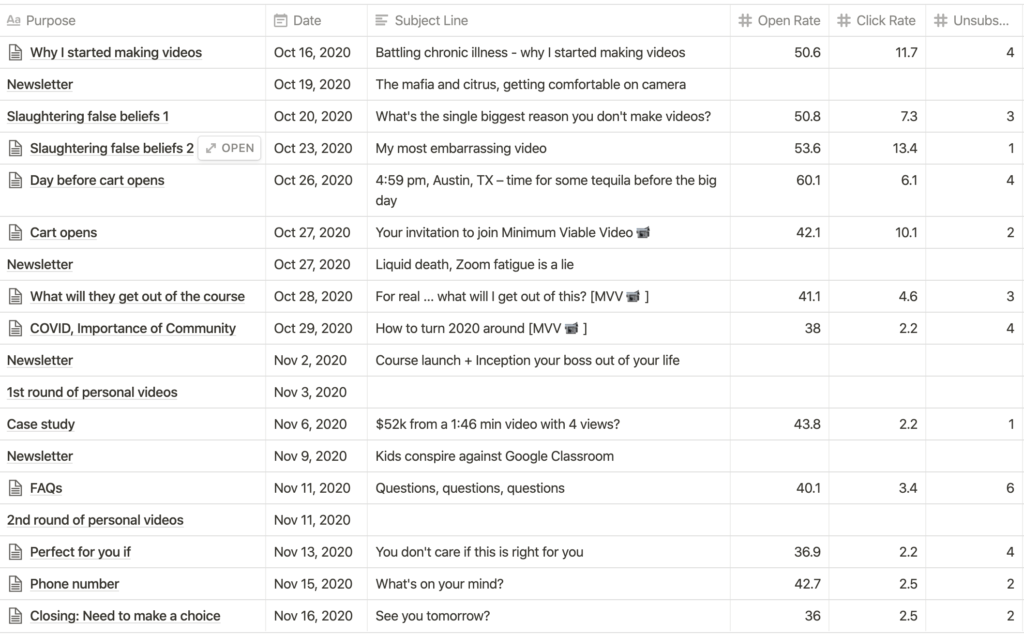
Personalized videos
Minimum Viable Video teaches how to use videos in creative ways to grow your business and accelerate your career. To prove that we walk the talk, we sent personalized videos to our audience.
In ConvertKit, we automatically tagged everyone who clicked through to our sales page. This produced a list of people who were at least somewhat interested in the course. Cam then filmed a short video for each person – 50 personal videos in total!
We uploaded these individual videos to YouTube using the unlisted status (only someone with the link can see the video). Using mail merge, we sent the videos out via email.
Responses were plentiful and positive. The personal videos indeed helped push some people “over the edge” to enrolling (as one of our students put it). But, this experiment also helped us understand why some people didn’t join.
Check out some of the responses we got:






Collaborations
The online course space is getting crowded. But instead of seeing other course creators as rivals who compete for students, we choose to look for collaborations that can benefit everyone.
For the first cohort of Minimum Viable Video, Cam teamed up with two other course creators to add value to each other’s cohorts.
The first is trial lawyer Robbie Crabtree who runs Performative Speaking. His course helps people speak more confidently and persuasively in any situation. Cam ran a session in Robbie’s cohort, introducing the basic lessons for getting started with video. In return, Robbie will teach a session on storytelling in Minimum Viable Video.
The second is YouTuber Ali Abdaal, who launched his Part-Time YouTuber Academy at the same time as Minimum Viable Video. His students learn how to grow and monetize a YouTube channel. Cam is teaching several sessions in Ali’s course, and Ali appeared in Minimum Viable Video for an intensive Q&A about all things YouTube.
In addition, Cam secured three more guest speakers for the course, which is an additional incentive for students to join.
Personal conversations
This launch wouldn’t have been a success without the many personal conversations Cam had with potential students.
We intentionally invited anyone to reach out if they had questions or just wanted to know if video was the right thing for their specific use case.
For that reason, we included Cam’s email on the sale page, always had a call-to-action to reach out on the bottom of every email we sent and even included his phone number in our second-last email of the launch.
As the kick-off date of the course drew closer, more people reached out. As you can see from the graph below, most students joined within the last seven days of the launch.
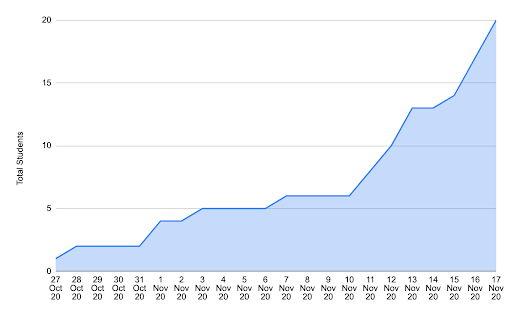
What else impacted the launch?
Timing
We were on the fence about launching at the end of 2020. The main reason was that the timing didn’t seem ideal with Thanksgiving in the middle.
Also, we heard from many people in our network that they had already taken a lot of courses this year and needed a break. Online course and zoom fatigue is a thing!
In the end, we decided to move forward, nonetheless, to sustain our momentum and get feedback faster.
As it turned out, more courses launched simultaneously, so we were not alone in capitalizing on one more opportunity to ship in 2020.
Takeaway: The ideal timing doesn’t exist! There’s always something else going on. The faster you ship, the faster you get feedback. And the faster you get feedback, the faster you can iterate and ship again.
Pricing
Originally, we planned to offer the course for $2,000 because of the highly personalized nature and individual attention and feedback. Cam even made a video about why the course is expensive. It never made it into the launch email sequence, though.
We had reserved a discounted price of $1,500 for early sign-ups. But in the end, we decided to keep the reduced price for the entire launch. Two grand for a new course seemed too much of a hurdle for people.
Takeaway: Be flexible and willing to adjust your pricing. What counts for the very first cohort is getting enough students to prove the concept. The goal is to provide an out-of-this-world experience that warrants glowing testimonials and helps build trust with the audience to drive sign-ups for the second cohort.
Effort
It’s probably safe to assume that everyone underestimates the effort it takes to start a course from the ground up. A lot of our attention went into this on a daily basis.
The great thing was that we split the load and could concentrate on what each of us does best, instead of trying to do it all alone. Our combined brainpower allowed us to come up with better ideas and constantly get feedback.
Takeaway: Find a partner in crime with a complementary skillset. You can’t be good at everything, and trying to be will wear you out. Also, it’s more fun to celebrate together.
Conclusion
Did we launch Minimum Viable Video too fast? Was the timing sub-optimal? Most likely.
Were we intimidated that a YouTube star like Ali Abdaal launched his course at the same time on a similar topic? Yep. Did it take sales away from us? Probably.
Was charging ahead still the right move? Hell yes!
We’re happy we did it because we now get to change the lives of 20 students by teaching them about video and how to use it the creative way.
With the first cohort steaming ahead, we have to think about the next one already. Every day, we’re learning about how to serve our students best and want to keep our momentum going.
That means continuing to grow our audience by sharing our journey and our students’ many wins.
If you’d like to follow along, connect with us on Twitter (click for Cam’s profile, click for Julia’s profile), and join the waitlist for the next cohort of Minimum Viable Video.
